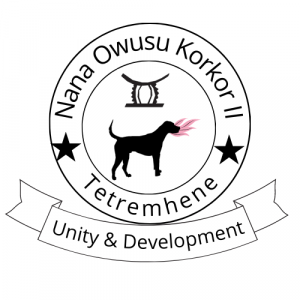
Tetrem, History and information
INTRODUCTION: Tetrem, popularly known as “Tottenham” or “Tot” in a short form, is a small growing urbanized town in the Afigya-Kwabre District of Ashanti Region, Ghana, West Africa. It has a population of over 10,000 people (contrary to 1997 estimate of 5000 people) living in an area of approximately 2.1 million square meters (0.8 sq miles). It is inhabited by a diverse group of people mostly Ashantis (“Asantes”) but also including migrants who have settled in the town to support farming and other occupations. These migrants include people from Northern Ghana, the Fantis from coastal Ghana and a few Gas from the Ghanaian capital, Accra. Tetrem has a rich history of culture, education and farming, having been the home of the Chief Farmer of Ghana for three consecutive years in the 1980s. Tetrem is also noted for its unique plantain called “Apem”.
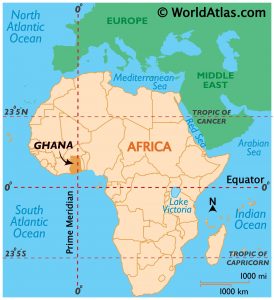
LOCATION: Tetrem is located 28 miles north of Kumasi, the regional capital of Ashanti. Using the road to the north from Kumasi, it is 14 miles from Kumasi towards Offinso, and 14 miles from Ahenkro towards Sekodumase. Tetrem is surrounded by other towns like Wiamoase and Bepoase on the east, Soko and Boamang on the south, Kyekyewere and Sekyedumase on the north and Offinso and Abofour on the west. (see map).
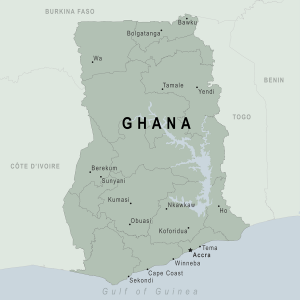
HISTORY: Like any royalty town, Tetrem has a rich history dating back to the 15th Century. It was originally settled by an Uncle and other family members of the then King of Ashanti. At that time some family members from the Asaman Kani Royal Family who ruled the State of Ashanti left their home at Atasomanso to do farming at the current site of Tetrem. After decades of war into the 17th Century, the then King of Ashanti (formerly Kwamang), Nana Obiri Yeboah who ruled from 1664 to 1697 recognized Tetrem as his uncle’s hometown giving Tetrem the stool name “ Osei Abobono” with its motto as “mete maboboano” (literally meaning, “I am sitting at my porch”). Over several hundred years, the leadership of the town was transferred to the Aduana family who stayed with and supported the Asaman Kani Royal family. The transfer was a reward for their hardwork, devotion and selflessness. Thus, the Chief of Tetrem is historically considered an uncle to the King of Ashanti. Therefore, his allegiance and traditional requirements to the Ashanti King and Queen are different from other Ashanti Chiefs. To attest to this historical account, in March 1999, a member of the Asaman Kani Royal family and a home town boy, Nana Dr. Isaac Kwame Takyi, (resident in the United States) contested for the Asante Kingship throne with the current King, Nana Osei Tutu II.
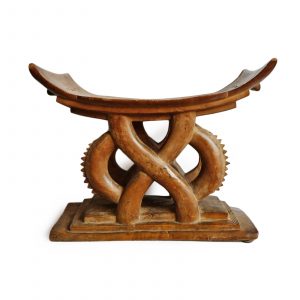
CULTURE AND TRADITIONS: The rich history of the town as recounted above makes it a mine of Ashanti culture, traditions and customs as every Ashanti practice like marriage, birth, funerals, cultural events, etc can be observed in the town. Today, the town organizes several events throughout the year with the most notable one being Easter Festivities during the month of April. On the Friday preceding Easter, a gala soccer match is played between the local team and visiting teams from the neighboring towns. Then on Saturday, a Record Dance is organized for the youth and on Sunday, the festivities end with Easter Harvest at the local churches to raise funds for development activities.
ADMINISTRATION: Tetrem is administered by two sets of leadership who work hand-in-hand to manage the day-to-day operations of the town as well as implement provisions in the town’s strategic development plan. The first set of leadership is the Chief, Nana Osei Kwame II and his elders made up of the linguist (Opanyin Kwame Afreh), Gyaasehene (Nana Anane), Krontihene (vacant) and the “queen mother”. The second set of leadership is about six to eight executive members of the Unit Committee elected by the District Assembly. The Chief and his elders exercise authority and power over land and development issues, social events, culture and traditions whereas the executive members implement policies of the government as they relate to community facilities and services. Revenues for development are obtained from housing development levies, funerals and other social fines. Tuesdays serve as market days as well as a special day for communal labor by adults in the town.
OCCUPATION: The primary occupation of Tetrem is farming mostly cocoa farming. In the 1980s, for three consecutive years, the Chief Cocoa Farmer of Ghana, Nana Kwaku Nokore (deceased), came from Tetrem with all his cocoa farms developed in and around the town. There were other reputable cocoa farmers in the town who had extensive farms that took days and weeks to harvest the cocoa seeds. Over the years in the late 1980s and early 1990s, the main stay of the local economy (cocoa farming) collapsed due to the extreme dry season causing hunger and bush fires that destroyed the farms and people’s livelihood. Since then the town has been struggling to survive socially and economically. Other farming activities include production of foodstuffs (like plantain, cocoayam, cassava, etc), oil palm, fruits (like orange, pineapple, etc) and vegetable farming. These activities have not had any noticeable effects on the local economy but keep the residents living at a subsistence level. One unique type of plantain called “Apem” that is produced in Tetrem is noted all over the Ashanti region and the nation as the best apem you can ever found. Thus, the nickname, “Tetrem Apem”, is a sought-after commodity by traders. There are no factories, civil service jobs, mineral activity and financial services industry in the town.
EDUCATION: There are seven elementary (Junior Secondary) schools and one Senior Secondary school in the town. The elementary schools are District Assembly (DA) Primary A & B (formerly called L A Primary A & B), Methodist Primary, Islamic Primary, New Foundation International, Owusu KoKo International and Banko Primary. Current enrolment of the primary schools stands at 4200 pupils. The senior secondary school with an enrolment of over 500 students is called Osei Tutu II College (named after the current King of Ashanti, Nana Osei Tutu II) (See pictures of some of the schools in Adopt a Project Initiative (API)). As depicted in the pictures, the elementary schools are in a serious state of disrepair. Classrooms are dilapidated, some without blackboards and other teaching aids; are non-cemented with dust blowing everywhere and majority have no windows and doors; roofs leak and in some cases, some classrooms don’t have roofs; tables and chairs are few and broken (with some children standing during classes); school compounds are safety hazards with serious erosion, broken bottles and tree stumps sticking out of the ground in many places and with little or no grass cover. The schools need urgent financial and development support to bring them to a humane level for child education.
HEALTH: There is a small health center facility with a maternity clinic attached. The Health center is staffed with one Health Assistant who oversees over 300 patients within a week with little or no medical aids or drugs. There are no bandages, plasters or gauzes to dress wounds, basic drugs to treat common medical ailments like headaches, stomach aches, allergies and cough. The maternity clinic has a few beds with no linens and basic hygienic supplies.
WATER: Drinking water in Tetrem is obtained through twelve (12) non-mechanized bore holes concentrated in the eastern portion of the town. Because the boreholes are not mechanized, there is no aeration or chlorination and therefore can be contaminated. With some of the bore holes frequently unable to produce enough quantities during dry seasons, residents travel long distances to fetch water from outlying streams like Akyekyeresu, Abankro and Kootano. These streams are frequently polluted with human waste that travels downstream to the places where town inhabitants use the water.
HOUSING: There are over 300 inhabited homes in the two basic housing areas of the town – “old town” and “new town”. The old town consists of six communities namely, Petenyinase, Aboaso, Besease, Bonkaso, Behinase and Zongo. Majority of houses in the old town are constructed with red mud using aluminum and thatch roofs. Most of the thatch roofs are in the “Zongo” area. Those in the new town area are constructed with blocks using galvanized aluminum roofing. As expected, the houses in the old town are in need of major repairs requiring reroofing, new painting, plastering and other forms of face-lifting. Erosion control is a serious problem affecting foundations of buildings to the point where homes are seen to be “pitched up high” making them vulnerable for destruction by strong winds or heavy rains.
ELECTRICITY: Electric power is supplied by the Barekese dam with one transformer supporting the needs of the town and its environs. Like many towns in Ghana, life is disrupted by intermittent supply of electricity, sometimes residents going for several days with no electricity. There are no street lights but a few isolated public lights needing constant care.
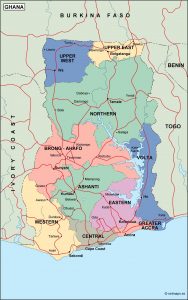
ROADS AND TRANSPORT: Road infrastructure is poor. The main connecting road to the town was recently tarred but all other roads and street network are untarred. Most of the roads are seriously affected by erosion to the extent that some streets have become “serious deathbeds for falling accidents”. Roads from the outlying villages become impassable during rains causing foodstuffs and cocoa produce to rot in the farms. Roads in the new town are not fully constructed as some houses block land reserved for roads and other street furniture. There is one government operated public bus (“metrobus”) plying to/from the town to Kumasi. In addition there are a few privately owned lorry cars picking up both farm produce and people to/from Kumasi. Sedan cars owned by individuals for their own transport are few. With the total transport equipment few, medical emergencies often result to deaths due to inability to get transportation to take people with emergencies to the nearby St. Joseph’s General Hospital in Maase, Offinso.
RELIGION: There are three main religions – Christians, Muslims and traditionalists. Majority of the people are Christians and like many Christian towns in Ghana, church going is a major activity on Sundays. There are three main traditional churches – Methodist, Roman Catholic and Salvation Army, and several non-traditional churches including The True Church of Christ, True Revival Church and Peace Pentecostal. Islam is the primary religion for the people in the Zongo area and villages around the town.

COMMUNITY FACILITIES AND SERVICES: The town has a reconstructed palace, one police station and four toilet facilities locally called “bomber latrines”. There is no public library as well as a community center where township residents can congregate for public events. The Police Station has only two staff members (the Sergeant and a private policeman). This is woefully inadequate to maintain peace and protect life and property. The bomber latrines are also grossly inadequate causing some residents to resort to uncivilized ways to “free their vowels” or “ease themselves”.